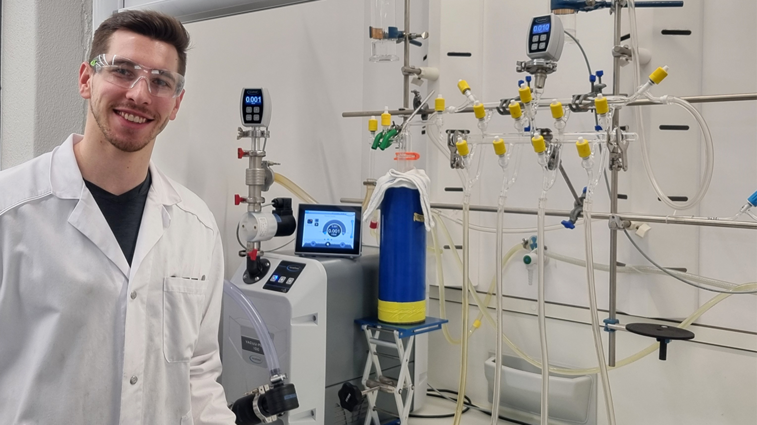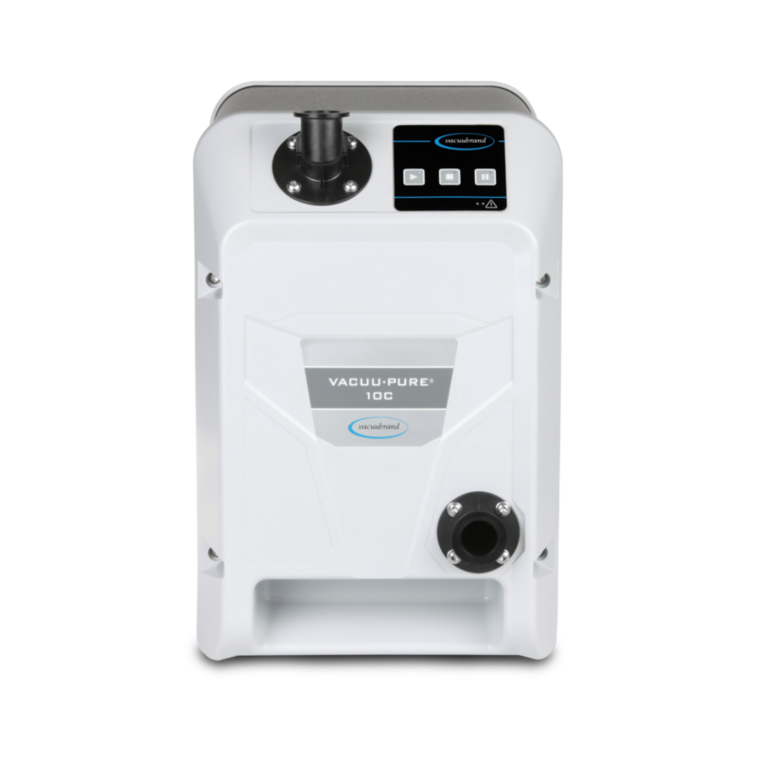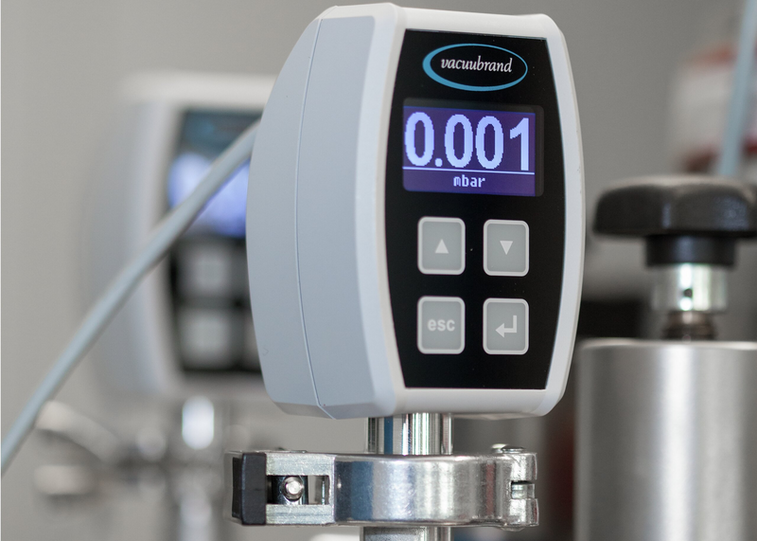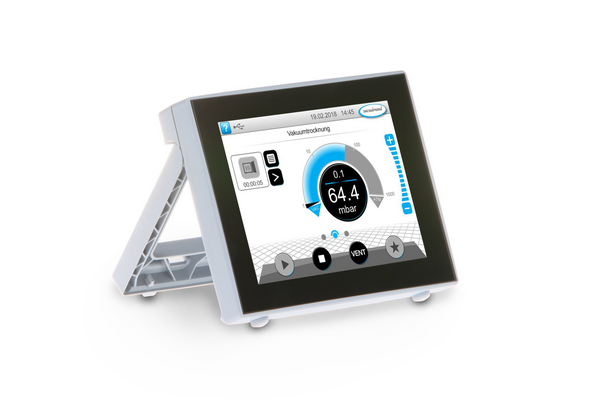
Andryj Borys relies on modern vacuum pumps, controllers, and gauges from VACUUBRAND at the Schlenk line.
Dr. Andryj Borys has a bit of a reputation as a “Schlenk Line king”. This is because of his personal blog "Schlenk Line Survival Guide“, where he shares valuable advice from his own laboratory practice. Thousands of followers meanwhile follow him on social media and benefit from his clear instructions and tips. As a student and post-doctoral researcher, he has also gained a wealth of experience with vacuum technology and passes this knowledge on to young chemists. Like others of his generation, he appreciates advanced digital devices that make his everyday laboratory work easier. He has already had good experiences with VACUUBRAND – from vacuum gauges and controllers to the latest vacuum pump.
What is special about the Schlenk Line Survival Guide?
With the Schlenk Line Survival Guide, I wanted to save others time on research so that they can benefit directly from existing experience. My goal is to provide modern and contemporary knowledge transfer for the next generation of chemists. (Andryj Borys)
Andryj Borys is a young, motivated research chemist, currently working as a post-doc at the University of Bern in Switzerland. During his previous positions in the United Kingdom and Canada, he became familiar with the Schlenk line as an important standard application in the laboratory. Thanks to his hands-on mentality, he documented his insights into proper handling even at that time.
The problem: Borys recognized the difficulty of obtaining all of the information in conventional ways. Some of the literature was over 40 or 50 years old and often not accessible online. This way of knowledge transfer no longer suited the modern learning preferences of future students and researchers.
The solution: a concise presentation of complex information that is accessible to everyone on the internet. In doing so, Borys has struck a chord with a growing generation of chemists who value his efficient learning style. Instead of sifting through countless sources and asking various people, they are able to find a contemporary solution within his practical online guide. From short texts to illustrative lists and pictures, readers are able to quickly and easily learn how to carry out individual steps and perform individual tasks correctly and safely. What began as personal notes has now developed into a popular knowledge base providing significant time savings for thousands of laboratory users!
What role does vacuum play for the Schlenk line?
"You can't have one without the other. Air and moisture are the enemies of the Schlenk Line. That's why we need vacuum pumps to evacuate the reaction flasks quickly and reliably," explains Borys. The relevance of vacuum is clearly evident in his work within Professor Eva Hevia's research group at the University of Bern. The team is dedicated to investigating sustainable syntheses and catalysis in the field of polar organometallic chemistry.
Advantages of vacuum on the Schlenk line
- Minimize moisture and oxygen exposure
- Gentle removal of high-boiling solvents at lower temperatures
- Efficient distillation, sublimation and residual drying

VACUU·PURE® 10C screw pump
Why screw pumps for the Schlenk line?
In Borys‘ laboratory, there are approximately 20 vacuum pumps in use for Schlenk lines and glove boxes. Traditionally, oil-sealed rotary vane pumps were used here to ensure the required pressure down to 10-3 mbar. "You can imagine the mess when we have to change the oil at the end of the year," says Borys, talking about the side effects of the well-known pump type. That's why he was all the more delighted when the oil-free vacuum pump VACUU·PURE 10C made its way into the laboratory.
Borys was eager to test the promise of the innovative screw pump: to be both chemically resistant and oil-free while still achieving the necessary pressure levels. The entire laboratory team were given the opportunity to use it, and word soon spread about this exciting new addition to their lab: Even researchers from other laboratories inquired about the pump for their applications.
Easy and oil-free to the desired pressure
The big difference compared to conventional rotary vane pumps is that the VACUU·PURE 10C screw pump saves us valuable time: first of all, we don't have to worry about whether we need to change the oil. Furthermore, it's simply a nice sleek box where we just press 'Play' and it works. The ease of use and efficiency are really impressive. (Andryj Borys)
According to Borys‘ experience, conventional rotary vane pumps have a rather analog and mechanical characteristic. The user receives limited information about what exactly is happening and how to identify the cause of problems. These pumps communicate sparsely and can occasionally be somewhat temperamental. It is not uncommon to arrive in the laboratory in the morning and first have to perform an oil change or ballast the pump for half an hour. This creates a notable level of uncertainty regarding reliability.
In contrast, he sees the VACUU·PURE 10C screw pump as a more advanced, digital technology. It is very easy to set up and operate – simply "plug and play" – and then works reliably to achieve the desired pressure. Therefore, the innovative vacuum pump represents a technological edge and precisely meets the requirements of students and researchers because it provides them with a more reliable working method.
Borys‘ tip! The oil-free screw pump is a perfect alternative to rotary vane pumps. Note that, like almost all pump types, it requires some warm-up time until the desired pressure is reached. Therefore, you simply switch on the pump immediately when you arrive in the laboratory in the morning and want to use the Schlenk line, get yourself a cup of coffee, and after 15-30 minutes, the pump will be ready for use! Once the pump is warmed up, it can even evacuate large flasks (e.g., 500-1000 ml) faster than rotary vane pumps.
Andry Borys and the lab team use the VACUU·PURE 10C vacuum pump for basic and advanced Schlenk line techniques, including:
- Routine synthesis, including cycling glassware onto the Schlenk line and removing solvent under vacuum
- Extensive drying of solids/oils to remove residual solvent
- Purification via distillation and sublimation under dynamic vacuum
- Static vacuum distillation (vacuum transfer) of solvents and degassing via the freeze-pump-thaw method
- Drying molecular sieves

VACUU·VIEW extended vacuum gauge
With digital gauges and controllers towards Vacuum 4.0?
In addition to the innovative screw pump, Borys is also enthusiastic about the digital vacuum gauges and controllers from VACUUBRAND. He had already become acquainted with the VACUU·VIEW extended vacuum gauge during his training. This dual sensor gauge allows precise vacuum measurements throughout the range from atmospheric pressure down to 10-3 mbar. Borys shares his enthusiasm: “I can really recommend the vacuum gauge VACUU·VIEW extended because, compared to traditional PIRANI gauges, it is digital and compact."

VACUU·SELECT vacuum controller
In conjunction with the VACUU·PURE 10C screw pump, Borys recently also tested the VACUU·SELECT digital vacuum controller. He had never experienced the vacuum control possibilities of such a device at the required 10-3 mbar on the Schlenk Line before and was immediately impressed. “I wish I'd had the VACUU·SELECT earlier. The precise vacuum control is a game changer for my daily laboratory work. We use it extensively throughout the lab for vacuum distillations and vacuum sublimations."
Reproducible results
With its intuitive graphical user interface, the controller not only enables predefined vacuum processes for common laboratory applications but also allows for the tailored compilation of applications, vacuum, and other parameters. For example, if Borys conducts a distillation today at 60 °C at 0.2 mbar, he can be sure that the process will run the same way next week, and is therefore reproducible. “This is important for our expensive reagents, which sometimes equate to the cost of an entire Schlenk line setup. You simply want to have the right equipment for such procedures. That's why it's really cool that the VACUU·SELECT allows you to run everything in a customised and controlled way," Borys rejoices.
User management for more safety
The controller also enables practical user management as an optional function extension. This allows multiple accounts to be created for different user groups with different access rights, which is ideal for students and researchers. This would also be an interesting feature for Borys: “The user management offers an important additional safety. With rotary vane pumps, for example, it quickly becomes dangerous if liquid oxygen accumulates in the cold trap. We could therefore prevent unauthorised persons from accidentally opening the vacuum valve."
What's next for the future?
Andryj Borys says about the time after his post-doctoral position at the University of Bern: "My plan is to lead my own independent research group back in the United Kingdom. Innovative high-tech devices like the VACUU·PURE 10C screw pump represent a technological edge over conventional pumps. Combined with digital vacuum controllers and gauges, they will hopefully continue to support me in optimizing my work as much as possible in the future."
We would like to thank Dr. Andryj Borys and the University of Bern for the interview.
